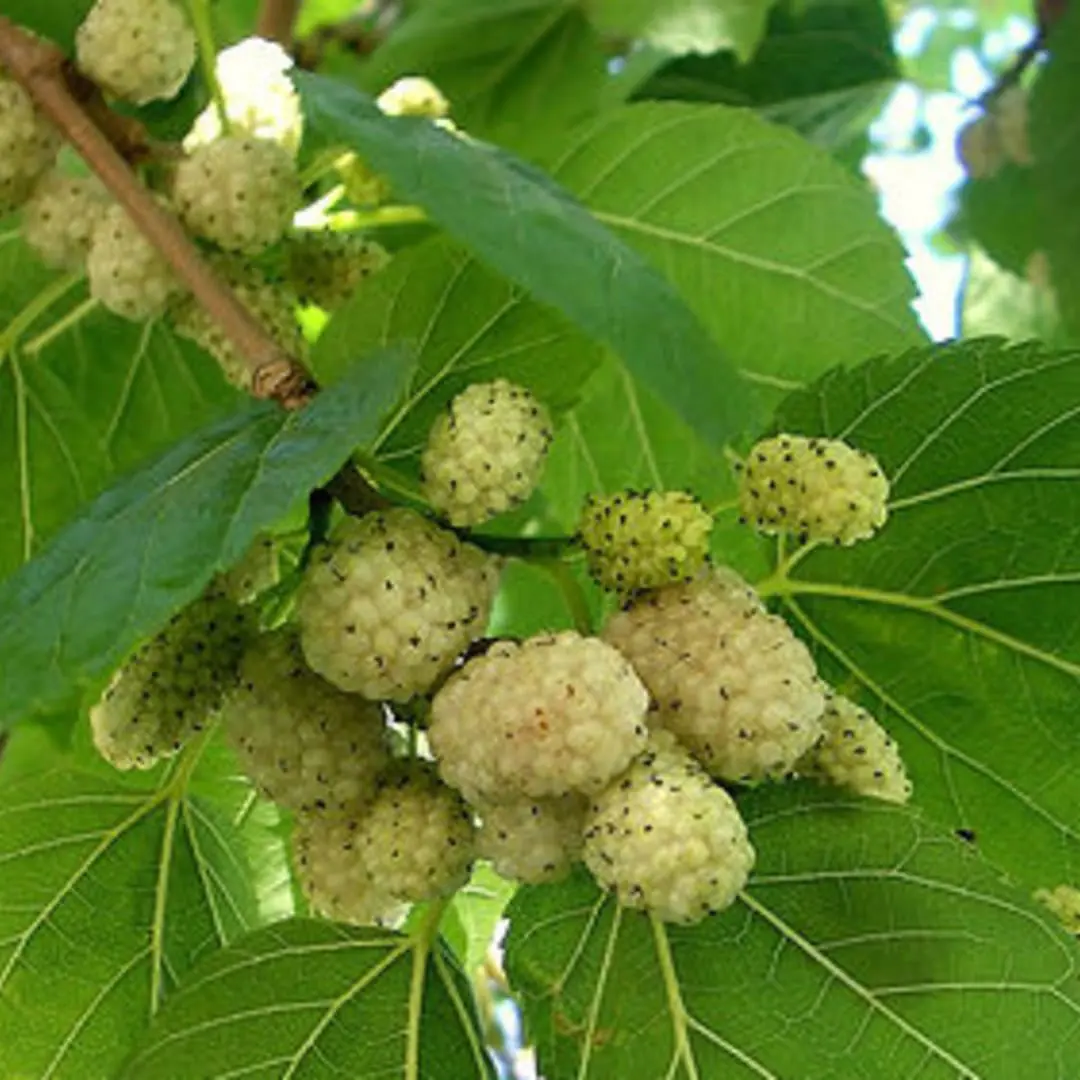The mulberry tree is well known across the United States and Europe, as well as throughout Asia. We may first think of them as prodigious bearers of deep red and almost black berries, which can stain everything they touch. The white mulberry (Morus alba) is our subject here, and in most respects the tree differs from its darker-berried cousins only in the color of the fruit it bears. A very odd characteristic unique to the white mulberry tree is the way in which it distributes its pollen. The flowers’ stamens act as catapults, releasing stored elastic energy in just 25 microseconds. The result is pollen being flung at the rate of about 350 miles per hour! This is said to be the fastest known movement in the plant kingdom!
Another and perhaps more widely known characteristic of the white mulberry tree is the fact that their leaves are the sole food of silkworms. Cultivation of the white mulberry tree began over 4,000 years ago in china specifically so silkworms could feed on its leaves. Thanks to trade along the Silk Road, Europeans developed a love of silk and attempts were made to replicate what the Chinese had been doing for thousands of years. Among the most successful were the French who essentially cornered the European market. When King James I of England tried to cultivate mulberry trees so England could get in on the silk market, he imported 10,000 mulberry trees from all over Europe and required landowners to plant them. Unfortunately, James was unaware of the silkworms’ exclusive taste for the leaves of the white mulberry tree, and his trees were the darker berried trees. His project failed, but his own mulberry garden survived until it disappeared when Buckingham Palace was rebuilt. Descendants of the trees that had been planted all over England can still be found on estates. Charlecote Park in Warwickshire has a receipt dated 1713 for a tree that survives to this day.

So, we know silkworms preferred white mulberry leaves over everything else. But what benefits are available to humans from the tree? Going back to the Chinese again, we find that the plant’s medicinal properties were discussed in the traditional Chinese medicine text book, Huang DiBa Shi Yi Nan Jing (Yellow Emperor’s Canon on Eighty-One Difficult Issues). White mulberry leaves were prescribed for coughs, diabetes and ‘tonification’ of the blood. Ancient Indian Ayurvedic texts recommended tea made from the tree’s leaves to combat colds and to promote sweating.
Coming forward into present day, research is being done in the use of white mulberry leaf tea for treatment of arteriosclerosis and diabetes. Other studies have shown that consuming an extract of white mulberry can help the body process sugar. One compound found in the plant (DNJ) has the ability to eliminate excess sugar from the blood. Multiple studies have also shown that eating white mulberry lowers cholesterol in humans. And just 1/3 cup of dried white mulberries contains 4 grams of protein and 20% of required daily fiber. The berries are also high in flavonoid antioxidents, vitamins C, A, K, E and B-complex, as well as iron, potassium, magnesium and manganese.
More Information
Sources:
Is White Mulberry The Next Superfood?
http://www.foodmatters.com/article/is-white-mulberry-the-next-superfood
History of Mulberry Trees
https://www.tytyga.com/History-of-Mulberry-Trees-a/373.htm
The turbulent history of the mulberry
http://www.telegraph.co.uk/gardening/how-to-grow/the-turbulent-history-of-the-mulberry/
What is White Mulberry Fruit?
http://www.ethnoherbalist.com/how-to-lower-blood-sugar-white-mulberry-benefits/
Effects of Mulberry Leaf Extract Rich in 1-Deoxynojirimycin on Blood Lipid Profiles in Humans
https://www.ncbi.nlm.nih.gov/pmc/articles/PMC2935155/
Videos:
White Mulberry Tree Releasing Pollen
https://www.youtube.com/watch?v=A0gmPf-hs1I


